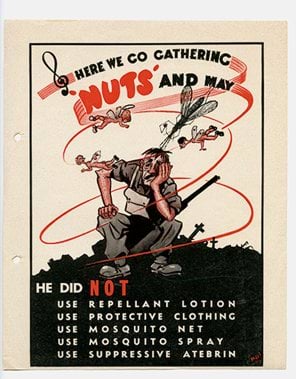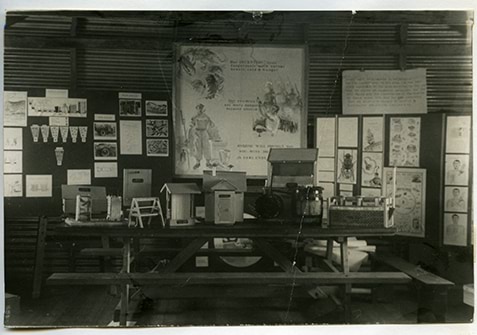
- Conflict:
- Second World War (1939-45)
- Service:
- Army
High rates of illness and disease in the armed forces was considered by Australian army officer Major Henry Shannon to be more dangerous than the enemy. A recent donation of items belonging to Shannon reveal the efforts medical personnel like him went to in order to protect troops during the Second World War. One document in this collection records that between September 1943 and 25 February 1944 over half the Australian troops stationed in New Guinea were evacuated: 47,534 due to sickness and only 3,140 as battle casualties.
Shannon’s collection of sketches, flyers, posters, photographs and medical equipment tell of his resolve to ensure troops abroad were healthy and clean.
Shannon wanted to make it clear that bugs are more dangerous than bullets. He worked with the Land Headquarters (LHQ) School of Hygiene, based in Bougainville, to educate those serving on the importance of maintaining a hygienic environment, especially in tropical service conditions. It was easy for troops to drop their personal hygiene standards while away from home and fighting in the jungle, so Shannon designed appliances that could assist. These included incinerators, urinals, fly traps, toilets and clothes boilers made from four-gallon drums, bamboo and rope. Shannon even created small-scale models of these appliances as teaching aides for the school.
These models were displayed alongside posters showing the dangers of disease, and how easily it could be combatted. One example titled Here we go gathering ‘nuts’ and may shows a soldier—pale, sick and unhappy—circled by ‘mosquitos’ representing Hitler, Mussolini and the Japanese Emperor Hirohito singing the nursery rhyme. These posters were designed to be comical to appeal to the troops and encourage better practices. This poster speaks to the danger of not protecting yourself from mosquitos and malaria whilst poking fun at the enemy.
Other posters in Shannon’s collection relate to clean water. With no running water, sterilising outfits were distributed as part of a standard kit. The tablets could be added to a water canteen to make ‘suspicious’ water fit for human consumption. Shannon believed these simple precautions, the appliances he created and the water sterilisation outfits, could prevent tens of thousands of people being taken out of action due to bug bites, flies and dirty water.
Discover more about the near devastating effect of malaria on the Australian troops in the Pacific on our podcast ‘Lessons Learned’ with Professor Geoffrey Quail. Podcast episodes are available through the Shrine website shrine.org.au/podcasts or your preferred podcast app.
Author:
Tessa Occhino is an Exhibitions Research Officer at the Shrine of Remembrance.
Updated

